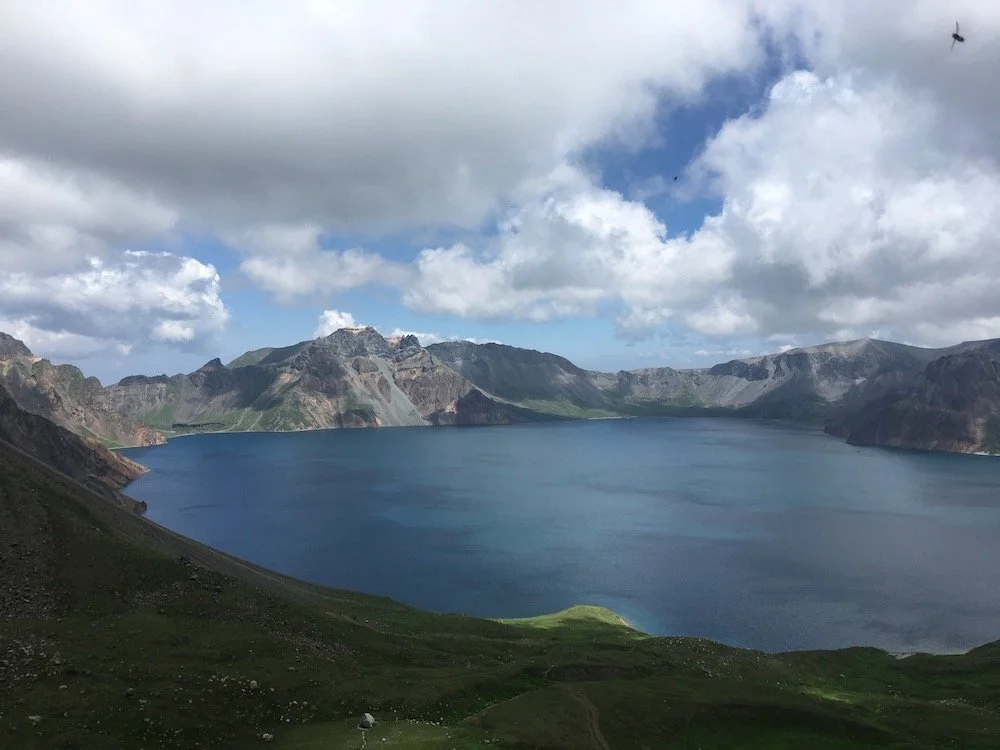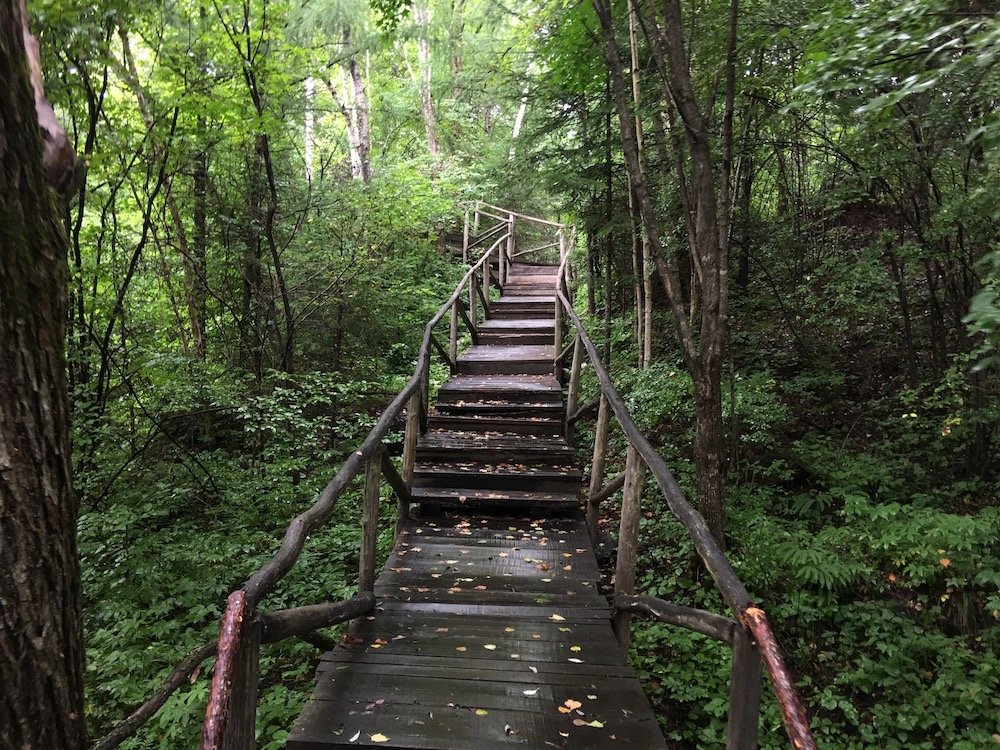Straddling the North Korean Border
Well, kind of. The only place in the world that you can physically stand atop the line that divides the Koreas is that little blue hut at the DMZ. You know, the place where we always see photo ops of officials from both sides meeting, usually with the south requesting that the north pretty please stop developing weapons that could wipe them off the map and the north requesting the south to stop sending over balloons with USB drives containing soap operas.
Americans can no longer visit North Korea as tourists, and flying to South Korea seemed like a lot of work. Daqing is not all that far from North Korea, as the crow flies. That got my wife and me thinking: how close can we really get from the Chinese side? There’s the port of Dandong - a new shipping hub in northeast Asia - and the Broken Bridge, but you’ve still got a wide river dividing China and North Korea. We wanted to get so close that you could, while not advisable, quite literally throw a stone across the border.
After a bit more research, we found an ideal location: Changbaishan.
A cultural pilgrimage
Except, don’t call it Changbaishan, or Mount Changbai, around Koreans. To them - both North and South Koreans - it’s Mount Paektu, the cultural birthplace of the Korean Peninsula. It holds such significance that it features in North Korea’s national emblem and has a mention in both countries’ national anthems. North Korea even invokes the peak’s name to promote certain domestic products, such as the Paektusan rocket and the Paektusan computer.
According to legend, Dangun, the founder of the first Korean kingdom, emerged from the crater at the top of the volcanic peak. Like, came straight out of it. From that point, Korea was a thing. This legend and the mountain’s prominence throughout history have made it a cultural pilgrimage destination for Koreans.
While visiting the peak in North Korea’s northern mountainous region is nigh impossible for South Koreans due to obvious political barriers, they can reach it from the Chinese side in Jilin province. China has turned the mountain and surrounding nature preserve into a massive tourist hotspot. We’ll get into that later.
“According to legend, Dangun, the founder of the first Korean kingdom, emerged from the crater at the top of the volcanic peak. Like, came straight out of it.”
Nature interrupted
The Changbaishan nature preserve is divided into the northern, southern, and western slopes. You can all guess where the eastern slope is. My wife and I decided to visit the western slope because everything we read online suggested that there would be fewer people. Remember that. Fewer people. Also, there is a bit more of a trek - 1,442 steps to be exact - to reach the edge of the caldera where you can peer into Heaven Lake if you’re lucky enough to have clear weather.
We wanted to avoid the northern slope since the bus takes people directly to the top. Where’s the fun in that? It also meant that it would be much more crowded. We took a bus from an adjacent hotel to the park gate, then walked all of 200m through a silver birch forest only to get onto another bus. These are special eco buses that ferry visitors throughout the park, and it’s your only ride. No other vehicles are permitted within the park.
There were some wild hairpin turns on the way to the slope that had everyone laughing, apart from a little girl across from us that had a look of abject terror on her face. Although we were driving right along the border, you wouldn’t know it. There was nothing to suggest that the most repressive regime on Earth was just a few hundred meters to our right.
We did see one Chinese tower that was likely on the lookout for North Koreans trying to cross into China. Many North Korean defectors begin their journey in the surrounding area, using the mountains as cover. It’s the first station on the North Korean Underground Railroad, which I did not know about until I read this gripping article while researching Changbaishan.
The mountain itself could have been the lovechild of the prehistoric rocky landscape of Iceland and the rolling grassy hills of England’s Lake District. As the epicenter of many violent eruptions, the blast radius was clearly defined by the steady increase of plant life that eventually merged with the forests below.
As we took in the sights, there was a deafening record scratch upon rounding the final turn and taking in a different, almost equally impressive sight: a heaving river of humanity flowing up and down the mountain. “Oh my god.” I can’t remember if it was me or Kate, but someone said it. Could’ve been both. It was assembly line tourism. Busloads of people arrived, busloads of people left. There was no point in waiting for an ebb because it wasn’t coming.
“After passing the friendly submachine gun-toting PLA soldier, we reached the summit.”
We jumped into the massive queue between busloads and quickly lived the experience of a salmon swimming upstream during spawning season. The physical act of walking up the steps and mental exercise of dodging slow tourists and sidestepping sedan chairs carrying the ailing and elderly made it difficult to focus on the view. There was quite a view to greet us when we took a moment to look back. The low, rolling vistas reminded me a lot of the Blue Ridge Mountains back home apart from being more green than blue.
After passing the friendly submachine gun-toting PLA soldier, we reached the summit. If the path up to the crater was hectic, the viewing platform was an agoraphobe’s worst nightmare. The deep turquoise water of Heaven Lake was beautiful, but there was no way to get a proper look at it unless you quite literally fought your way to the front, dodging selfie sticks along the way. It was quite surreal. Here was a scene of real natural beauty, one of the most anxiety-inducing crowds I’ve ever been in, and North Korea. It was a lot to process.
Getting there
China is blessed with a wealth of natural beauty, but getting there is always a pain in the ass. Depending on how many hours you spend on a bus, you may take that as a literal statement. China has next to no infrastructure for foreign tourists, therefore some level of Mandarin Chinese will make the difference between an enjoyable trip or a stressful nightmare. If you don’t speak Chinese, plan your route thoroughly in advance and have a translation app handy. I recommend Youdao Translate because it does not require a VPN.
Most people will start in Changchun, Jilin’s capital, and take a bullet train to Dunhua. Ignore advice in the top results for Changbaishan suggesting you take a train to either Baihe or Songjianghe. This is the slow train that will take you 12 and 14 hours, respectively, and you will be miserable. From Dunhua, you will take a 3-hour bus to Erdaobaihe, where most of the hotels are located. If you book a hotel that is closer to the park, you will need to hire a private car. Most hotels will put you in touch with a driver via WeChat.
Where to stay
There are plenty of hotels to choose from in Erdaobaihe, the closest sizable township to the mountain. There are also a few hotels very close to the park gates. You’ll need to hire a private car from Erdaobaihe to get there, however, and there is very much a local price and a foreigner price. Bear that in mind and try to ask a local to help you book a reputable driver, if possible. There are a lot of assholes circling like sharks at this leg of domestic travel in China.
Unfortunately, some hotels in China do not have licenses to accept foreigners. Yes, this is an ass-backward and arguably downright racist policy, but it is what it is. To avoid any surprises, use a website like booking.com to find a laowai-friendly hotel. Hotels in Erdaobaihe will be more budget-friendly while resorts near the park gates will be more pricey.
We chose to stay at a resort near the West Slope park gate, and it was worth it. If you’re staying in Erdaobaihe, it’s a further 35 km drive to the North Slope park gate and a 77 km drive to the West Slope park gate. If you factor in the added cost of a private car from Erdaobaihe, you might spend just as much staying there as you would staying closer to the park where most resorts can arrange transport to the gates.
“Unfortunately, some hotels in China do not have licenses to accept foreigners.”
Prepare yourself
Most people that would choose to go to an obscure place like Changbaishan are probably expats who have already visited the tourist hotspots in Beijing, Xi’an, and Sichuan province. If that’s the case with you, then you know full well what to expect. However, if you just happen to be in the area for a few days and it’s your first time going through the tourism meat grinder within China, you should prepare yourself.
Simply put, any historical or natural place in China that has millions of government yuan put into it is going to be absolutely swamped with people. That investment builds the kind of infrastructure required to move such a massive population up to the top of a mountain and back down again. If you are a Western tourist, you will not find the tranquility you might seek at a place of natural beauty.
It’s a tough tea egg to crack. I’m of two minds. On the one hand, who wants to be surrounded by thousands of loud and pushy people in a place that should be untouched and serene? However, if that infrastructure to get those people there wasn’t in place, it could be irreparably destroyed by people visiting the site anyway. This is something I thought about a lot while visiting Changbaishan, and it will be something I talk about in detail next time! ◉
Written by Seth Barham














